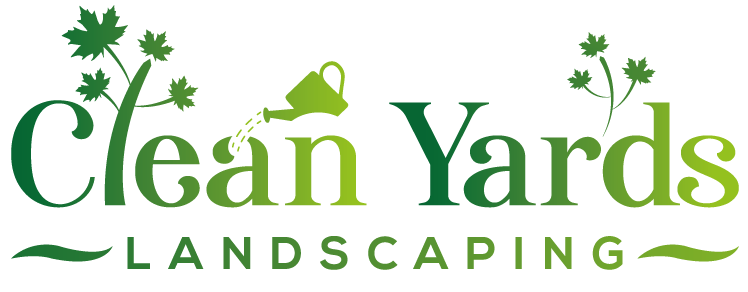Relieve Barrhaven Soil Compaction After Winter Snow (54)
Winter's heavy snow can leave Barrhaven lawns compacted and struggling. Is your lawn showing signs of stress? Request a quote today to discuss professional aeration and soil health solutions.
Quick Summary: Lawn Compaction Relief
- What it is: Soil particles squeezed together, reducing space for air, water, and roots. Caused by winter snow/ice, clay soil, and traffic.
- Signs: Puddling water, runoff, thin/patchy grass, hard soil (check with screwdriver test).
- Best Fix: Core aeration (pulls soil plugs out) is recommended for Ottawa's clay soils.
- Best Timing: Spring (April-May) or Fall (Aug-Sept) when grass is actively growing.
- Boost Results: Follow aeration immediately with topdressing (compost) and overseeding.
- Prevention: Mow high, water deeply/infrequently, manage foot traffic, grasscycle clippings.
Introduction: Thawing Out Your Barrhaven Lawn - Why Winter Leaves it Breathless
Okay, Ottawa winter survivors, give yourselves a pat on the back! The snow is retreating, the Rideau Canal skate season is a fond memory, and we can finally see our lawns again. But wait... does your Barrhaven grass look a bit worse for wear? Maybe a little *flattened*, tired, and gasping for air after months under a heavy blanket of snow and ice? You're definitely not alone.
Winter in our region, from Nepean right across to Barrhaven, puts our yards through a serious workout. All that heavy snow and ice pressing down for months, plus the constant freezing and thawing cycles, does a real number on the ground beneath. It squeezes the tiny air pockets out of the soil, leading to a common problem called *soil compaction*.
Imagine your lawn's soil getting packed down so tightly it can barely breathe! This compaction is a big headache for your grass because it blocks essential air, water, and nutrients from reaching the thirsty grassroots. It’s like trying to drink through a clogged straw – frustrating and not very effective!
But don't despair! A compacted lawn isn't a lost cause. This guide is your spring lawn rescue plan. We'll walk you through why this happens and, more importantly, practical steps you can take – like tackling thatch and understanding the magic of *aeration* – to help your Barrhaven lawn breathe easy and get back to its glorious green self this growing season. Let's wake up that turf! For comprehensive lawn recovery, consider exploring professional lawn care options.
What is Soil Compaction? Unpacking Winter's Squeeze on Your Yard
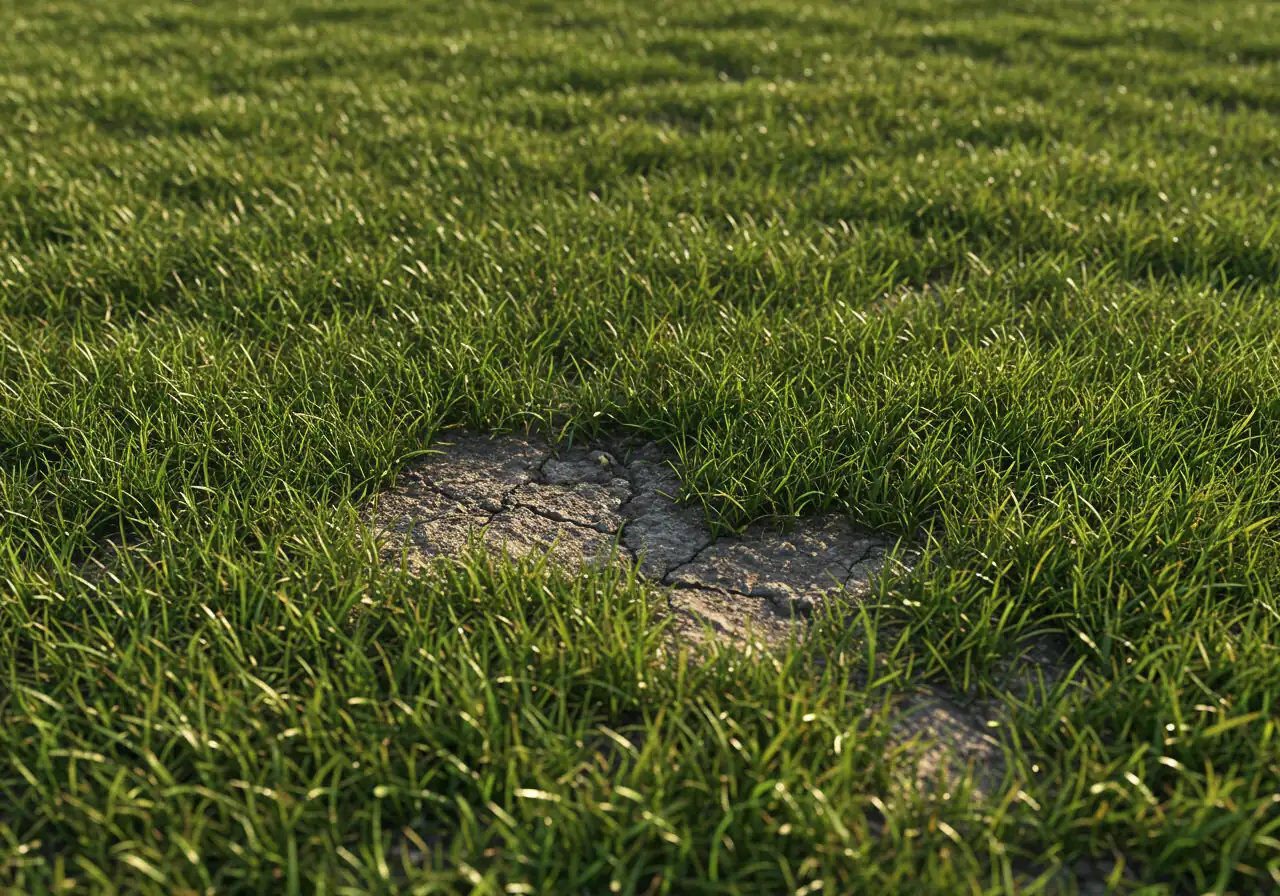
So, what exactly *is* this soil compaction villain we keep mentioning? Imagine your lawn's soil is like a big, fluffy sponge, full of tiny pockets for air and water. Healthy plant roots love wiggling through these spaces to find everything they need to thrive. Now, picture someone repeatedly stepping on that sponge, especially when it's wet. *Squelch!* All those lovely air and water pockets get squeezed shut, leaving the sponge dense and flat. That, in a nutshell, is soil compaction! It's the process where soil particles get pressed together, reducing the pore space between them. Less space means less room for the good stuff – air, water, and nutrients – and makes it tough for roots to grow.
Here in Ottawa, our winters are practically experts at causing compaction. First, there's the sheer weight of all that snow and ice sitting on your lawn for months. It acts like a constant press, slowly squeezing the soil beneath. Then comes the freeze-thaw cycle – winter’s little game of expansion and contraction. When water in the soil freezes, it expands, pushing soil particles apart. But when it thaws, gravity and the weight above can cause those particles to settle even *closer* together than before. This is especially true in areas with heavier clay soils, which are common around Ottawa, including spots like Greely and parts of Nepean. Clay particles are tiny and stick together easily when wet and under pressure, making them more prone to compaction compared to sandier soils.
How can you tell if your lawn is suffering from winter's squeeze? Your yard often gives clues! Keep an eye out for these signs:
- Puddles forming on the lawn after rain or snowmelt, instead of soaking in.
- Water running off quickly, potentially carrying away topsoil and fertilizer. Dealing with runoff is tricky; compacted soil makes it harder for water to penetrate, highlighting why understanding things like efficient watering strategies (perhaps inspired by Metcalfe summer drip irrigation systems for water conservation) can be crucial for getting water *to* the roots, not just *over* the surface.
- Thinning grass or bare patches where turf struggles to grow. If your grass looks weak overall, it might be time to investigate comprehensive Nepean lawn care solutions for a healthy yard.
- Rock-hard soil that’s difficult to penetrate with a shovel or screwdriver. Trying to plant flowers or shrubs can feel like digging through concrete – you'll definitely appreciate having ergonomic garden tools, like those useful in Vernon during fall cleanup, when tackling compacted ground!
- Increased weed growth, as some weeds are better adapted to tough, compacted conditions than desirable grass species.
Compacted soil basically puts your lawn on life support. Roots can't breathe, drink, or eat properly, leading to stressed, unhealthy grass. Healthy soil is the foundation for a vibrant yard, whether you're aiming for perfect turf or trying to create a beautiful Manotick wildlife haven by attracting birds through landscaping. If you suspect compaction is choking your lawn, don't worry, there are solutions (which we'll get into!). And if diagnosing or tackling soil problems feels overwhelming, exploring professional landscaping and lawn care services is always a great option.
Playing Detective: How to Spot Compaction in Your Barrhaven Soil
Okay, grab your metaphorical magnifying glass and deerstalker hat – it's time to play lawn detective in your own Barrhaven backyard! Figuring out if your soil is compacted doesn't require fancy lab equipment, just a little observation and a trusty tool you probably already have.
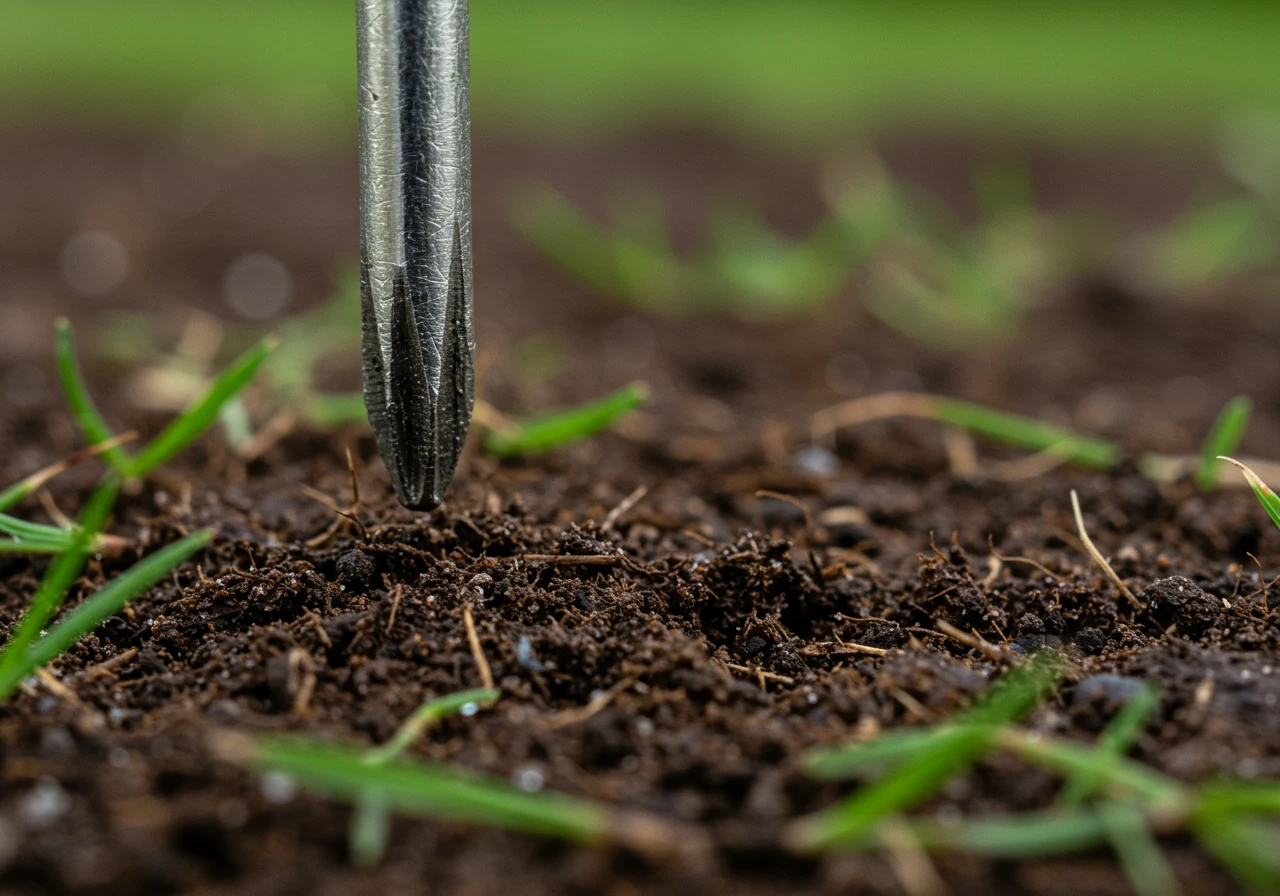
Your Primary Clue: The Screwdriver Test
This is the easiest, most hands-on way to check for compaction. Think of it as taking your soil's pulse. Here's how to do it:
- Wait for the right conditions: The best time to test is a day or two after a good rain, or after you've watered your lawn thoroughly. You want the soil moist, but not soaking wet mud. Trying this on bone-dry, mid-summer Ottawa soil will *always* feel hard, even if it's healthy!
- Grab your tool: A long screwdriver (at least 6-8 inches) is perfect. A sturdy metal rod works too.
- Push it in: Choose a spot on your lawn and try to push the screwdriver into the soil using just your body weight (don't jump on it!).
- Feel the resistance:
- Easy Peasy: If it slides in easily, penetrating 4-6 inches or more without a major struggle, your soil likely has good structure in that spot. Hooray!
- Hitting a Wall: If you meet significant resistance within the first couple of inches and can barely push it deeper, that's a big red flag for compaction. It means grassroots will struggle just as much!
Don't Stop There! Look for Visual Evidence
Your eyes are great tools too. Keep an eye out for these tell-tale signs around your property:
- Puddle Problems: Does water sit on the surface long after rain stops, especially in low spots? Compacted soil can't absorb water quickly, leading to poor drainage.
- Patchy, Stressed Grass: Are there areas where the grass looks thin, weak, or yellowish, even with adequate watering and fertilizer? Roots suffocating in compacted soil can't support healthy top growth. You might notice these patches correspond with areas where the screwdriver test was difficult.
- Runoff Issues: During heavy rain, do you see water sheeting off the lawn instead of soaking in? That's valuable water (and potentially topsoil) being lost. Consider advice from local resources like the Rideau Valley Conservation Authority on managing water runoff.
- Weed Invasion: Some tough weeds actually *thrive* in compacted soil where grass struggles. If dandelions or plantain seem happier than your turf, compaction might be helping them win.
Test Multiple Locations!
Don't just test one spot and call it a day. Compaction is rarely uniform across an entire lawn. Test areas that get heavy foot traffic (like the path to the shed or where the kids play soccer), compare them to less-trafficked spots near flower beds, and check any visibly struggling patches. Getting a feel for different zones gives you a much clearer picture. If you find widespread issues or the problem areas are cluttered with debris or old thatch, getting professional help like an Ottawa yard cleanup service can clear the way before you tackle the soil itself. Dealing with heavily compacted areas might require more than just aeration; sometimes a full Ottawa property cleanup service is needed to reset the stage. And remember, whether it's diagnosing compaction or needing help with lawn restoration, exploring different landscaping and lawn care services can provide tailored solutions. Residents specifically looking for assistance nearby might consider options like a Nepean property cleanup service for localized expertise.
By playing detective and using these simple techniques, you can diagnose compaction early and take steps (like aeration, which we'll cover next!) to help your Barrhaven lawn breathe again.
The Fix is In: Choosing the Right Aeration Method for Ottawa Lawns
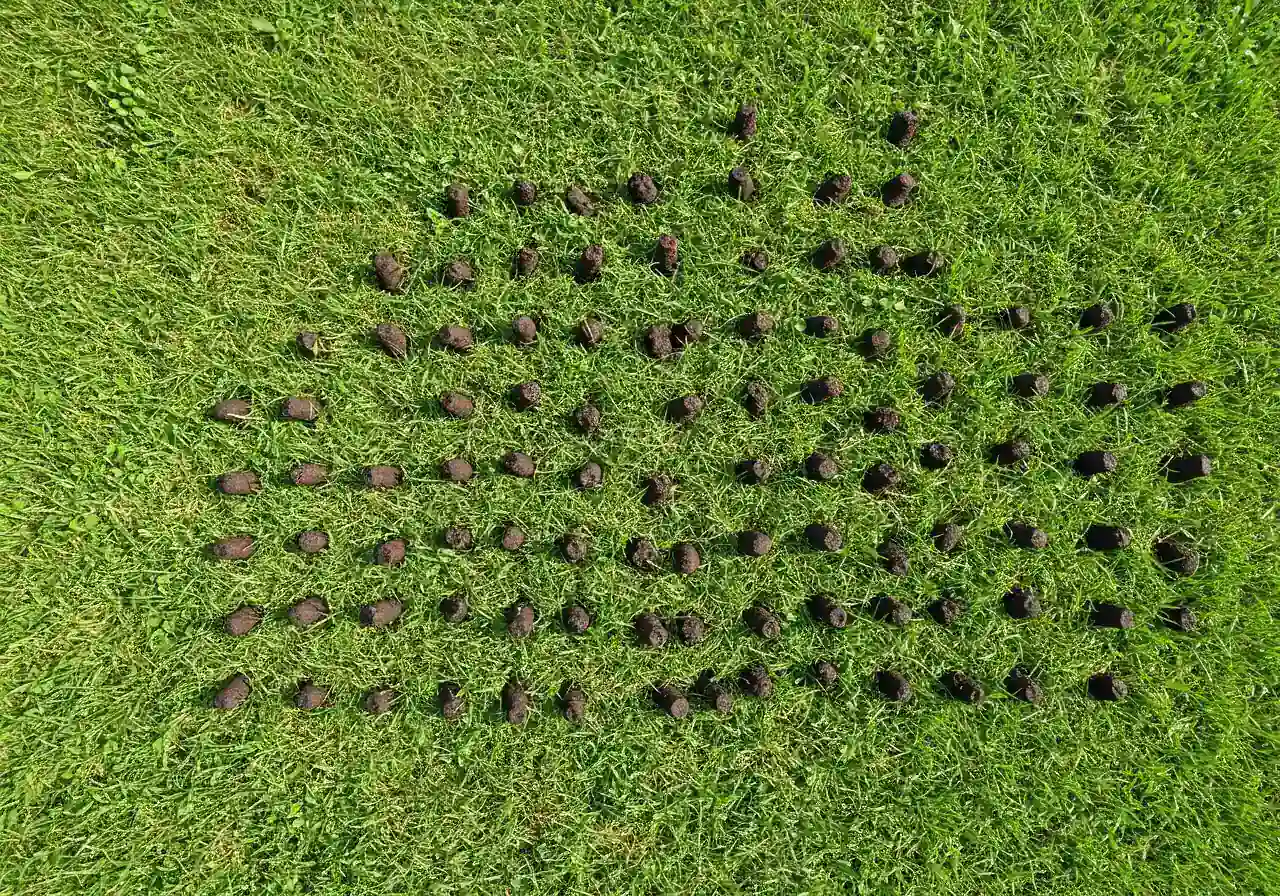
Alright, so you've played detective, poked around with a screwdriver, and confirmed your lawn is feeling the squeeze – probably tighter than trying to find parking near Parliament Hill on Canada Day! You know compaction is the enemy, but what's the fix? The hero of this story is *lawn aeration*. Think of it as CPR for your turf, opening up airways so it can breathe, drink, and feed properly again.
But wait, there's more than one way to aerate a lawn? Yep! Let's break down the two main players: Core Aeration and Spike Aeration.
1. Core Aeration (The Champion for Ottawa Soil)
- How it Works: This is the method we generally recommend for our local conditions, especially in areas with heavier clay soil like Greely or parts of Nepean. A core aerator machine uses hollow tines to physically pull small plugs (or "cores") of soil and thatch right out of the ground, usually about ½ to ¾ inches wide and 2-3 inches deep.
- The Benefits: This is the *real deal* for relieving compaction. By removing soil plugs, it creates actual space for air, water, and nutrients to penetrate deep down to the roots. It also helps break down thatch buildup. Those little soil plugs left on the lawn might look messy for a week or two, but they quickly break down, returning valuable nutrients and organic matter to your soil – a bit like natural composting! This method promotes deeper root growth and a more resilient lawn. Before you start, ensure your lawn is clear of leaves and debris; a good prep step might involve an Ottawa garden clean up service if things are looking messy. The decomposition of these cores adds beneficial organic material back into the soil, which aligns with the principles of using quality inputs, much like focusing on thoughtful landscape material selection for garden beds.
2. Spike Aeration (The Quick Poke)
- How it Works: Spike aerators use solid tines (like spikes, imagine that!) to simply poke holes into the ground. Think of aerating sandals or rolling tools with spikes.
- The Drawbacks: While it might seem helpful, spike aeration often provides only very temporary, superficial benefits. Worse yet, especially in our common Ottawa clay soils, the action of pushing solid spikes *in* can actually *increase* compaction in the soil immediately surrounding the hole. It essentially just compresses the soil sideways. It doesn't remove any material, so the space created is minimal and short-lived.
Core vs. Spike: The Showdown
| Feature | Core Aeration | Spike Aeration |
|---|---|---|
| Compaction Relief | Excellent, long-lasting | Minimal, temporary |
| Thatch Reduction | Good, helps break it down | Very little effect |
| Air/Water Flow | Significantly improves | Slightly improves, short-term |
| Root Growth | Encourages deeper roots | Little impact |
| Ottawa Clay Soil | Highly Recommended | Not Recommended* (can worsen things) |
| Soil Plugs | Yes (they break down beneficially) | No |
The Verdict for Ottawa: Given our typical soil conditions, core aeration is almost always the superior choice. It provides genuine, lasting relief from compaction, which is the primary goal.
Manual vs. Machine
You *can* find manual core aerating tools (they look like sturdy pogo sticks with hollow tines). They work, but aerating an entire lawn manually is a serious workout – probably more effort than wrestling with garden edging after a long winter! For anything larger than a tiny patch, renting or hiring a gas-powered core aerator machine is far more practical and effective. These machines cover ground much faster and more consistently.
Why Core Aeration is Eco-Friendly
Beyond just helping your grass look good, core aeration is a green choice! By improving water absorption, it reduces wasteful runoff (saving water and preventing fertilizer from washing away). Healthier, less-stressed grass is naturally more resistant to pests and diseases, potentially reducing the need for chemical treatments. And as mentioned, those cores decompose, adding organic matter back into your lawn's ecosystem. It truly helps your lawn help itself. While aeration revitalizes existing lawns, remember that for severely damaged areas, sometimes the best eco-conscious approach is a fresh start with high-quality turf via reliable sod installation. A well-aerated lawn also looks fantastic alongside neatly defined beds achieved through services like professional mulching and edging.
So, when it's time to give your Ottawa lawn some breathing room, choosing core aeration is the smartest fix!
Compaction problems holding your lawn back? Let the pros handle it!
Get Professional Help With Lawn AerationDIY Delight or Pro Performance? Aerating Your Lawn in Barrhaven & Beyond
So, you've identified that your lawn needs aeration – fantastic! You're ready to give those grassroots some much-needed breathing room. Now comes the big question rattling around many Barrhaven sheds and garages: should you roll up your sleeves and tackle it yourself, or call in the lawn care cavalry? Both DIY aeration and hiring professionals have their perks and pitfalls. Let's break it down like we're sorting LEGO bricks – finding the right fit for *you*.
Going the DIY Route: The Weekend Warrior
Renting a core aerator and doing the job yourself definitely appeals to the hands-on homeowner.
- Pros:
- Potential Cost Savings: Renting is usually cheaper upfront than hiring a service, especially if you already own a truck or trailer to haul the machine.
- Satisfaction Factor: There's undeniable pride in tackling a lawn task yourself and seeing the results. You work on your own schedule (within the rental period, anyway!).
- Learning Experience: You get up close and personal with your lawn's needs. For gardening enthusiasts, resources like the Master Gardeners of Ottawa-Carleton offer great local advice.
- Cons:
- The Equipment Hassle: Aerators are *heavy* and awkward! Getting it home from the rental place (often needing a truck or SUV), maneuvering it around your yard (especially on slopes or tight corners), and returning it on time can be a workout in itself.
- Sweat Equity Required: This is physical work. Pushing or guiding a vibrating, heavy machine across your entire lawn takes effort and stamina.
- Effectiveness Concerns: Rental machines might not be as powerful or well-maintained as professional-grade equipment. You might also miss spots or not achieve the ideal core depth/pattern without experience.
- Time Commitment: Factor in travel time for pickup/return, learning how to use the machine safely, and the actual aeration time. It can eat up a good chunk of your weekend. Plus, you need to clear the lawn first – removing toys, furniture, and maybe even needing significant prep like a professional yard cleanup service in Metcalfe if things have gotten out of hand.
Calling in the Pros: Convenience and Expertise
Hiring a lawn care company to handle aeration is often the path of least resistance. You can often find reputable local services through platforms like Google My Business.
- Pros:
- Maximum Convenience: They show up, do the job efficiently, and leave. Your weekend remains your own!
- Professional Equipment: Pros use powerful, well-maintained core aerators designed for optimal results. They know how to achieve the right depth and coverage.
- Expertise: Experienced crews know how to handle different lawn types, slopes, and potential obstacles (like sprinkler heads). They often offer aeration as part of a larger lawn care package.
- Efficiency: They can typically aerate a standard residential lawn much faster than a DIYer.
- Cons:
- Higher Cost: You're paying for the convenience, equipment, and expertise, so the price tag will be higher than a rental fee.
- Scheduling: You'll need to book the service in advance and work around their schedule.
Making the Call: What's Right for Your Ottawa Lawn?
Deciding between DIY and pro really depends on your specific situation:
- Lawn Size: Got a tiny Barrhaven townhouse lawn? DIY might be manageable. Overseeing a sprawling property out in Manotick or Osgoode? The time and effort of DIY might outweigh the cost savings – professional help looks much more appealing.
- Your Budget: If budget is the absolute top priority and you're physically able, DIY is tempting. Get quotes from professionals to compare; you can easily get a clear idea of professional costs and provide feedback on estimates to help you weigh the numbers.
- Your Time: How valuable is your free time? If weekends are packed, hiring a pro frees you up for other things – maybe even planning that dream garden installation your newly healthy lawn will complement beautifully.
- Physical Ability: Be honest with yourself. Are you comfortable handling heavy, vibrating machinery? If not, hiring is the safer and more comfortable option.
- Lawn Prep Needs: If your yard needs more than just aeration, like significant debris removal first, factoring in professional help like comprehensive property clean-up services in areas like Marionville might make bundling services with a pro more efficient overall.
Ultimately, whether you choose DIY delight or pro performance, the goal is the same: a healthier, happier lawn that can breathe easy. Weigh the factors, consider your circumstances, and choose the path that makes the most sense for you and your slice of Ottawa green space!
Aeration Benefits Overview
Boosts Oxygen to Roots
Core aeration creates channels that allow vital oxygen to reach the root zone. Grass roots need oxygen for respiration and growth, just like we do! Compacted soil suffocates roots, hindering their function and leading to weak turf.
Reduces Puddling & Runoff
The holes created by aeration allow rainwater and irrigation to penetrate the soil surface more easily instead of pooling or running off. This leads to more efficient watering, conserves water, and reduces the risk of fungal diseases associated with overly wet surfaces.
Fertilizer Works Better
When fertilizer can reach the root zone effectively through aeration holes, your lawn gets the maximum benefit from applications. Nutrients are less likely to be washed away by runoff, leading to healthier growth and less wasted product.
Helps Break Down Thatch
Core aeration physically removes plugs of thatch (the layer of dead grass stems and roots between green blades and soil) and brings soil microorganisms to the surface. These microbes help decompose the remaining thatch layer, improving overall lawn health.
Beyond Aeration: Long-Term Strategies for Healthy Soil in the Capital Region
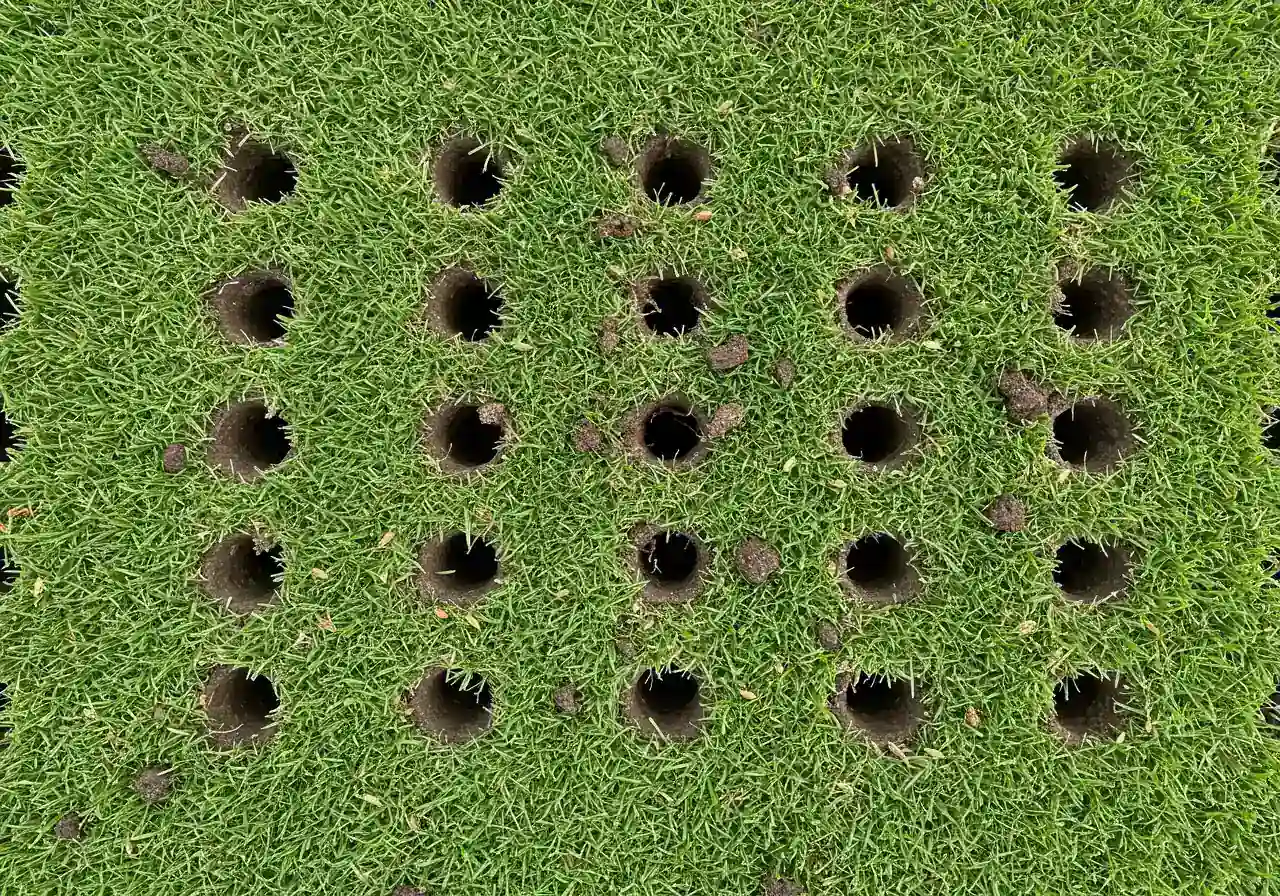
Okay, so you've decided to give your lawn that glorious spa treatment called core aeration – fantastic! Your grass is probably already sighing with relief. But just like one trip to the gym won't keep you fit forever (darn it!), aeration is a powerful *step*, not the final destination, on the road to truly healthy, resilient soil here in the Capital Region. Think of it as opening the door; now we need to keep the good vibes flowing for the long haul!
Timing is Everything: When to Aerate in Ottawa
Aeration is best done when your cool-season grass (that’s most Ottawa lawns!) is actively growing, but not under extreme stress. This gives it the best chance to recover and benefit. The two prime windows are:
- Spring (Mid-April to Late May): After the ground thaws but before the summer heat kicks in. This helps lawns recover from winter compaction.
- Fall (Late August to Late September): As temperatures cool, this preps the lawn for winter and takes advantage of good growing conditions for root development. Avoid aerating bone-dry summer soil or frozen winter ground.
The Power Trio: Aeration + Topdressing + Overseeding
Aerating punches all those lovely holes in your lawn. Now, how can we make the *most* of them? By following up immediately with topdressing and overseeding! It's like preparing the perfect seedbed.
- Topdressing: This simply means spreading a thin layer (about ¼ inch) of high-quality compost or screened loam over the lawn. Those aeration holes practically *beg* for this organic matter! It filters down, improving soil structure, adding vital nutrients, boosting microbial life (the good bugs!), and enhancing water retention over time. It's like giving your soil a vitamin boost.
- Overseeding: Scattering grass seed over the existing lawn, especially after aerating and topdressing, is brilliant. The seeds find perfect little pockets in the aeration holes, protected and in direct contact with improved soil, giving them a great head start. This helps thicken up thin areas, introduces more resilient grass varieties, and crowds out weeds naturally.
Combining these three steps creates a synergy that significantly boosts lawn health far more than aeration alone.
Estimated Lawn Improvement Over 1 Year
*Illustrative chart showing potential relative improvement in lawn density and health.
Preventing Future Compaction: Play the Long Game
Okay, we've fixed the current problem, but how do we stop our soil from getting that squeezed feeling again? It’s about smart lawn habits:
- Mow High: Keep your mower blade sharp and set it high – aim for 3 to 4 inches for most local grass types. Taller grass develops deeper roots (better at finding water and nutrients!), shades the soil surface (keeping it cooler and reducing evaporation), and is more resilient to stress. Think of it as giving your lawn a leafy sun hat!
- Water Wisely: Water deeply but infrequently. Instead of short, daily sprinkles, give your lawn a good long soak (enough to moisten the soil 4-6 inches down) once or twice a week, depending on rainfall. This encourages roots to grow down deep, making them less susceptible to surface compaction and drought. Let the soil dry slightly between waterings. The City of Ottawa offers tips on responsible watering practices.
- Manage Traffic: This is a big one, especially on damp soil! Try to vary your walking routes across the lawn. Install stepping stones or proper pathways in high-traffic areas – planning for this can be part of larger inspiring landscape transformations. Avoid parking vehicles on the grass (even temporarily!). If you have kids or pets creating worn paths, overseeding those areas regularly can help, but sometimes a landscape redesign is the best long-term fix.
- Leave the Clippings (Grasscycling): When you mow (and you’re mowing high, right?), leave the clippings on the lawn unless they’re excessively long or clumping. They break down quickly, returning valuable nitrogen and organic matter to the soil. It's free fertilizer!
- Seasonal Readiness: Keeping your lawn clear of excessive leaf litter, especially heading into winter, prevents matting that can contribute to compaction and disease. Sometimes a thorough fall property clean up is the best way to set your lawn up for success.
Building healthy soil is a marathon, not a sprint, especially with Ottawa's distinct seasons. By combining timely aeration with smart follow-up care and preventative practices, you’re investing in a greener, healthier lawn for years to come. It’s a commitment we understand well; it’s fundamental to who we are and what we do. As a team dedicated to local landscapes, from Richmond to Metcalfe and beyond, we believe healthy soil is the foundation of every beautiful yard. You can learn more about our approach and values on the Clean Yards About Us page. We take this stuff seriously, just like we take protecting your information seriously when you reach out to us – you can always review our straightforward Clean Yards Privacy Policy.
Barrhaven Lawn Rescue - Quick Compaction Relief Tips
Feeling like your Barrhaven lawn could use a breather after that long Ottawa winter? Soil compaction is super common, turning your yard into a pavement-like pancake where grass struggles. Don't sweat it! Here are some quick tips to get things breathing easy again:
- Do the Poke Test: Grab a long screwdriver and push it into moist soil (a day after rain is perfect). If you hit a wall within the first couple of inches, compaction is likely crashing the party. It’s a simple check anyone can do!
- Core Aeration is King: Forget those spikey shoe things! For our typical clay-heavy soils around Ottawa, core aeration is the champ. It pulls actual plugs of soil out, creating real space for air, water, and nutrients. Those little plugs break down – bonus points for natural recycling!
- Timing Matters: Aim to aerate when your grass is actively growing but not stressed – think spring (mid-April to late May) or fall (late August to late September). Avoid doing it on rock-hard summer dirt or frozen ground.
- The Power Trio: Make aeration count double! Follow up *immediately* by topdressing with compost and overseeding. The new holes are perfect little nests for seeds and organic goodies to boost soil health.
- Mow High, Water Deep: Keep grass blades around 3 inches tall to encourage deeper roots. Water thoroughly but less often to train roots downwards, away from surface compaction. These are key parts of comprehensive lawn care strategies.
- Clear the Way First: Aerating works best on a clear surface. If your yard looks like a disaster zone after winter or spring storms, consider getting debris removed professionally first. A clean slate, like you might get with a Metcalfe garden clean up service, makes aeration much more effective.
- Manage Foot Traffic: Try not to wear paths in the same spots, especially when the ground is wet. Use designated paths or stepping stones for high-traffic zones.
- Need Help or Inspiration?: Tackling aeration can be a big job. If DIY isn't your jam, professional help ensures it's done right. You can see the results of professional care in our Clean Yards project gallery. Existing clients can easily manage appointments or review past services, like aeration dates, through the Clean Yards customer portal.
Giving your lawn a little breathing room goes a long way towards that lush, green carpet everyone in Barrhaven envies!
Ideal Lawn Recovery Timeline (Post-Winter)
Early Spring (April)
Assess lawn for winter damage and compaction (Screwdriver Test). Rake lightly to remove debris and lift matted grass. Consider a spring property clean up if needed.
Mid-Spring (Late April - May)
Perform Core Aeration while grass is actively growing. Immediately follow with Topdressing (compost) and Overseeding for best results. Begin regular mowing (mow high!).
Late Spring (June)
Water deeply and infrequently based on rainfall. Monitor new grass growth from overseeding. Apply spring fertilizer if needed, based on soil health.
Summer (July - August)
Maintain high mowing height. Water deeply during dry spells, preferably early morning. Avoid heavy traffic on the lawn, especially when wet. Explore water-saving irrigation if needed.
Fall (Late Aug - Sept)
Ideal secondary window for Aeration, Overseeding, and Topdressing if not done in spring or if compaction persists. Apply fall fertilizer to promote root growth before winter. Ensure soil preparation is adequate.
FAQs: Tackling Soil Compaction in Barrhaven and Ottawa
Oh, winter definitely does a number on our lawns, but it's not the only culprit packing things down! Our region often features clay-heavy soil, especially noticeable in areas stretching from Barrhaven towards Greely. Clay particles are tiny and love sticking together, especially when wet – think less fluffy garden soil, more pottery class potential. Add in regular foot traffic (kids playing, paths to the shed, even just mowing), heavy lawn equipment, or parking vehicles on the grass (a definite no-no!), and you've got a recipe for squeezed soil that struggles to let air and water reach the grassroots. Even building a new home can leave behind heavily compacted ground from construction equipment. Consider specialized clean-up for other areas like Marionville yard cleanup service.
That's a great question! Not *every* lawn needs annual aeration, but many in the Ottawa area benefit greatly from it, especially those with that heavier clay soil or lots of activity. The best way to tell is to become a bit of a lawn detective. Do the screwdriver test we mentioned earlier – if it’s tough to push in more than a couple of inches when the soil is moist, your lawn is asking for help. Also, look for signs like puddling water or thinning grass. If your lawn gets heavy use, has dense clay soil, or you notice signs of compaction returning, then yearly core aeration (usually in the fall) is a fantastic investment in its long-term health. If your soil is looser and drains well, you might get away with doing it every other year.
Nope, put that rake away – you can relax! Those little plugs, or cores, are actually lawn gold. Leave them right where they fall. They contain beneficial soil microbes and organic matter. As they break down over a week or two (mowing helps break them up too!), they return valuable nutrients to your soil and help decompose thatch. Think of it as free, natural topdressing! Raking them up removes these benefits. Embrace the temporary polka-dot look; your lawn will thank you for it later.
Great thought! DIY aeration can save some money upfront, but those core aeration machines are heavy beasts to transport and maneuver. If you go DIY, *definitely* mark the location of all sprinkler heads, invisible fence lines, or shallow utility cables *before* you start – you don't want an accidental "oops!" that requires repairs. Renting means dealing with pickup and return, too. Hiring a professional service takes the hassle away; they have the right equipment and experience. They'll know how to get consistent coverage and should ask about sprinklers. Before committing to a service, it's wise to understand what's included; reputable companies usually have clear service details like those found in our Clean Yards terms and conditions. If you're weighing the cost, you can easily book an estimate for lawn aeration to see how professional service fits your budget.
Awesome job opening up those airways! The absolute best follow-up punch is to immediately overseed and topdress with compost. Those aeration holes create the *perfect* little pockets for grass seed to germinate safely and for nutrient-rich compost to work its way into the soil structure. This combo helps thicken the lawn, improve soil quality over time, and crowd out weeds. Also, make sure your lawn was clear of heavy leaf litter or debris *before* aerating for best results; sometimes a good prep job, similar to what a Metcalfe property cleanup service might provide, makes a huge difference. Taking these extra steps maximizes the benefits of aeration. We genuinely value seeing homeowners achieve healthier lawns; it's as satisfying for us as seeing the confirmation on our Clean Yards Thank You page when a client successfully books help online!
Conclusion: Give Your Barrhaven Lawn Room to Breathe!
So there you have it – the lowdown on why your Barrhaven lawn might feel like it’s holding its breath after winter! That notorious Ottawa freeze-thaw cycle and heavy snow really pack down the soil, making it tough for your grass to thrive. But don't despair! Core aeration is your lawn's best friend, acting like a deep breath that creates much-needed space for essential air, water, and nutrients to reach thirsty grassroots.
Giving your lawn room to breathe isn't just fancy talk; it's crucial for achieving that lush, green growth everyone envies. Remember, combining timely aeration with smart long-term strategies like proper watering, mowing high, and focusing on good soil preparation techniques makes all the difference for lasting health. A vibrant lawn is often the centerpiece of a beautiful yard, perfectly complementing flower beds and garden spaces that shine with consistent garden maintenance.
Getting the best results often means starting with a clean slate – if winter left a mess of leaves or debris, tackling that first (similar to the focused work involved in our Marionville garden clean up service) ensures aeration can be as effective as possible.
Ready to ditch the compaction and help your lawn breathe easy? Don't let your turf gasp any longer! Let's chat about giving your lawn the TLC it deserves this season. Reach out to the Clean Yards team through our simple online contact form today, and let’s get your Barrhaven lawn breathing freely!
Ready for a Lush Lawn? Let Us Help!
Okay, let's be honest. After learning all about soil compaction and the wonders of aeration, maybe the thought of wrestling a heavy aerator machine across your yard sounds... well, less fun than enjoying a cold drink *on* a beautiful lawn! We get it. Achieving that perfectly lush, green carpet of grass takes know-how, the right tools, and frankly, time and effort you might prefer spending elsewhere.
That's where we come in! Clean Yards specializes in bringing tired, compacted lawns back to life right here in Ottawa and surrounding communities. We know the challenges our local soil presents, from the clay stretches in Greely and Nepean to the specific needs of yards in Barrhaven, Manotick, Osgoode, and beyond. Why stress about DIY when professional results are just a click or call away? Let us handle the hard work so you can simply enjoy a healthier, greener lawn that breathes easy.
Ready to transform your turf? Here’s how we can help:
- ➡️ Get a Fast, Free Estimate: Curious about the cost? No problem! Click here for a no-obligation quote tailored to your lawn size and needs. It’s quick, easy, and the first step towards a happier yard.
- ➡️ Book Your Lawn Aeration Service: Know exactly what you need? Skip the guesswork and schedule your core aeration, overseeding, or complete lawn care package today.
- ➡️ Discuss Your Lawn Goals: Not sure where to start? Whether it's fighting compaction, tackling thatch, or aiming for the best lawn on the block, we're here to chat. Contact us to discuss your specific lawn challenges and find the perfect solution.
We proudly serve homeowners throughout the Ottawa area, including Barrhaven, Nepean, Manotick, Greely, Osgoode, Metcalfe, Richmond, Kars, Vernon, and surrounding neighbourhoods.
Explore All Our Lawn & Yard Services